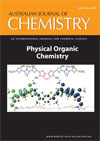
Australian Journal of Chemistry
Volume 67 Number 5 2014
RESEARCH FRONT: Physical Organic Chemistry
This Research Front is dedicated to the highly interdisciplinary field of Physical Organic Chemistry.
CH13554Minimalist Approaches to Protein Labelling: Getting the Most Fluorescent Bang for Your Steric Buck
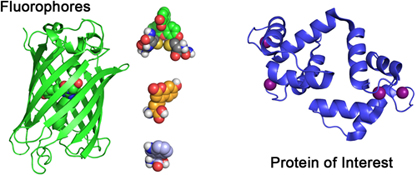
This review examines several strategies for fluorescently labelling proteins with a particular focus on the trade-off between size and utility for fluorophores, where large size can be disruptive to the protein’s fold or function, but valuable characteristics such as visible wavelength absorption and emission or brightness require sizable chromophores.
CH13564Cobalt-Mediated Decarboxylative Homocoupling of Alkynyl Carboxylic Acids

Metal mediated reactions of carboxylic acids that produce reactive organometallics that can then be used in C–C bond forming reactions have attracted considerable interest. Multistage mass spectrometry experiments were used to uncover the first examples of cobalt-mediated decarboxylative Glaser-like C–C bond coupling of alkynyl carboxylic acids.
CH13528Effect of Extended Conjugation on the Optoelectronic Properties of Benzo[1,2-d:4,5-d′]bisoxazole Polymers
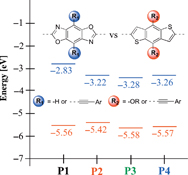
Four new one-dimensional and two-dimensional BBO–BDT-based copolymers were synthesised using Stille cross-coupling. The new polymers show tunable electronic and optical properties that vary with the location and number of extended conjugation monomers. Density functional theory was used to further elucidate the structure–property relationship of the polymers.
CH13522Diradical Character of Benzo- and Naphtho-Annelated Thiophene–Pyrrole Mixed Oligomer Dications
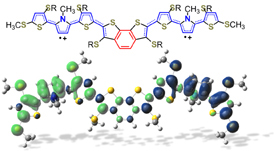
Cationic oligothiophenes are extensively studied as models of p-doped polythiophenes. However, little is known about the relationship between the structure and diradical character of the dications. In this study, a benzo-annelation process afforded enhancement of the diradical character, thus showing potential for designing π-conjugated oligomers for supramolecular chemistry based on π-dimerisation of radicals.
CH14054Quantum Coherence and its Impact on Biomimetic Light-Harvesting
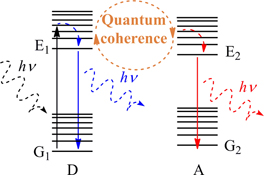
Recent experimental data is now suggesting quantum coherence takes places in relatively weakly (intermediately) coupled donor–acceptor systems including natural light-harvesting complexes. This highlight review seeks to give an overview of these developments for the benefit of chemists in areas such as synthetic chemistry and photovoltaic research.
CH13489A Class of Computationally Designed Tri-Coordinate Cyclic Silylenes RSi(µ-R)2AlR2
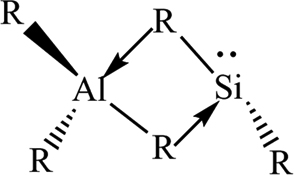
Low-valent silylenes, which contain a lone pair of electrons and one low-lying vacant orbital, are of interest for their unique chemistry and as potential synthetic precursors for various applications. This paper describes a new di-bridged tri-coordinate silylene, which is stabilised by intermolecular donor–accept interactions.
CH13456Improved Photocatalytic Activity of Copper Heterostructure Composites (Cu–Cu2O–CuO/AC) Prepared by Simple Carbothermal Reduction
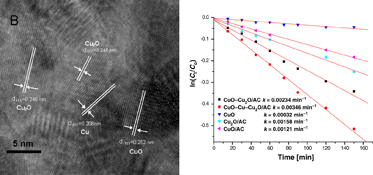
Activated carbon-supported Cu–Cu2O–CuO heterostructure composites with effective visible-light activity have been successfully synthesized by simple carbothermal reduction. The Cu–Cu2O–CuO/AC heterostructure composites showed excellent photocatalytic activity compared with other catalysts (pure CuO, Cu2O/AC, CuO/AC, and Cu2O–CuO/AC), which is ascribed to synergistic action between the AC support and photoactive copper species, and efficient transfer and separation of photogenerated carriers at the hetero-interface (e.g. Cu2O/CuO, Cu/Cu2O or Cu/CuO and Cu2O/Cu/CuO). Moreover, the composition of Cu–Cu2O–CuO /AC can be tailored by varying the Cu loading, heat-treatment temperature, and heat-treatment time.
CH13472Temperature-controlled Deposition of Copper(I) Oxide and Metallic Copper Nanostructures from Single-source Molecular Precursor

A new tetranuclear copper complex, [Cu(dmae)(TFA)]4 CH2Cl2 (1), was synthesized, characterized, and directly applied in AACVD to give morphology- and phase-tailored thin films of Cu2O and Cu nanowires for possible applications in tandem photoelectrochemical devices.
CH2Cl2 (1), was synthesized, characterized, and directly applied in AACVD to give morphology- and phase-tailored thin films of Cu2O and Cu nanowires for possible applications in tandem photoelectrochemical devices.
CH13570Synthesis, Structure, and Properties of a New ErIII Iodate
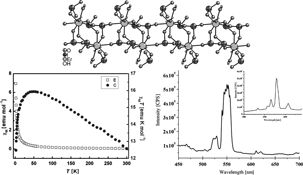
A new iodate Er(IO3)3·2H2O was synthesized under mild hydrothermal conditions. The overall framework of Er(IO3)3·2H2O is based on one-dimensional chains. The adjacent chains are further linked with each other by hydrogen bonds to form a three-dimensional supramolecular network. The luminescent and magnetic properties of Er(IO3)3·2H2O were also studied.
CH13580DABCO Promoted Regioselective Synthesis of New Diversely Functionalized 3-Hydroxy-2-Oxindole Scaffolds

An efficient and highly regioselective γ-addition of β-keto sulfones on isatins has been achieved in the presence of a catalytic amount 1,4-diazabicyclo[2.2.2]octane (DABCO) to afford a γ-(3-hydroxy-2-oxindole)-β-keto sulfone structural framework. The described method is very handy and provides straightforward access to diversely functionalized 3-β-keto sulfone substituted-3-hydroxy-2-oxindole structural scaffolds in good yields from readily available starting materials under metal-free conditions.
CH13619Synthesis and Crystal Structure of Oxygen-deficient Bilayer Ruthenate Sr3Ru2O7–δ
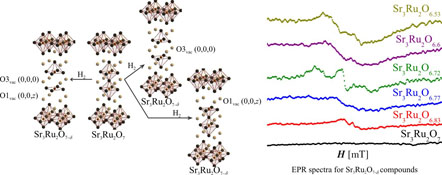
Sr3Ru2O7–δ reduced phases were obtained by H2-reduction of Sr3Ru2O7 compound. Electron paramagnetic resonance spectra showed the presence of Ru3+ in the reduced phases.
CH13632[Tris(alkoxydimethylsilyl)methyl]alkylferrocenes as New Ferrocenyl Multifunctional Silyl Ethers
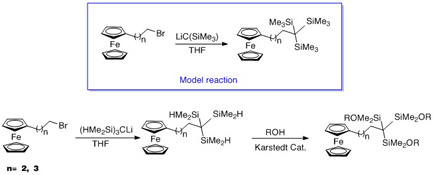
Ferrocenyl silyl ethers are interesting in organic synthesis, as intermediates for the synthesis of new compounds, and are used in the synthesis of redox electrochemically active materials and polymers. Ferrocenyl compounds are widely used in materials science, biology, and catalysts.
CH13617Synthesis of New-structured PbTiO3 Nanowires With Reversible Bending Properties
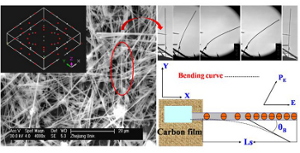
Uniform 1-D PbTiO3 nanowires with a new crystal structure were synthesized via a facile hydrothermal strategy, and featured reversible unidirectional bending behaviour.
CH13607Electrochemical Reduction and Detection of Nitrobenzene Based on Porphyrin Composite-modified Glassy Carbon Electrode
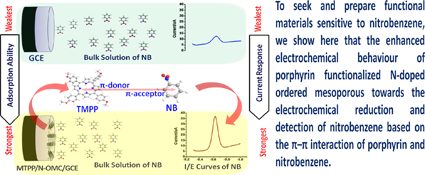
To seek and prepare functional materials sensitive to nitrobenzene, we show here the enhanced electrochemical behaviour of porphyrin-functionalized N-doped ordered mesoporous carbon towards the electrochemical reduction and detection of nitrobenzene based on the π–π interaction of porphyrin and nitrobenzene.
CH13572Free Radical Processes in Non-enzymatic Browning of Glucose and Lysine: Influence of Temperature and Unsaturated Lipids
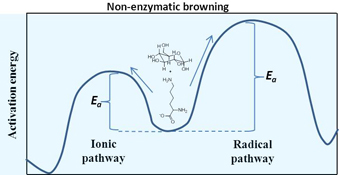
The balance between ionic and radical processes during non-enzymatic browning of glucose and lysine is strongly dependent on temperature, with ionic processes involving heterolytic bond cleavage dominating at lower temperatures. Lipids oxidation does not seem to influence this balance; contrarily, the effects of lipids on Maillard reactions for conditions of food processing are matrix-related.
CH13512Colorimetric Detection of Trace Arsenic(III) in Aqueous Solution Using Arsenic Aptamer and Gold Nanoparticles
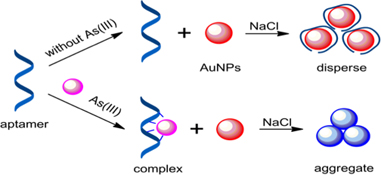
Owing to the high toxicity of arsenic(iii), AsIII, to the environment and human health, the development of sensors for AsIII detection has attracted worldwide attention. A simple and fast colorimetric assay for AsIII detection was designed using arsenic aptamer and gold nanoparticles.
CH13608Role of Pristine and Acid-Functionalized Fullerene on Breaking Dye Aggregates and its Impact on the Efficiency of Solar Cells

Porphyrins tend to aggregate on the surface of ZnO nanorods. Fullerene molecules have the potential to break these aggregates down through interaction with prophyrins.



